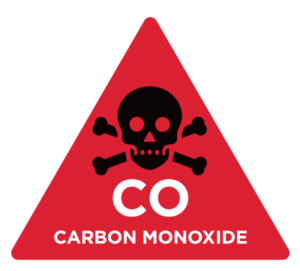Carbon Monoxide (CO)
- What is Carbon Monoxide?
Carbon monoxide (CO) is a deadly poisonous gas that is colorless, odorless and tasteless. It is undetectable to human senses. Meaning, the only way to know it is present before it causes injury or death is to have a carbon monoxide alarm.
Carbon monoxide can invade any enclosed or semi-enclosed environment. It can travel through homes and entire buildings via heating and air conditioning ventilation systems, through hallways and up stairwells. In high concentrations, it can permeate drywall .
- Where does CO come from?
Sources of carbon monoxide include fires in fireplaces and woodstoves, car exhaust, boat exhaust, charcoal grills, and any appliance, tool or device that uses these fuels: kerosene, gasoline, coal, natural gas, propane or methane.
- How can I protect my family from CO poisoning?
First and foremost HAVE carbon monoxide alarms. It is impossible to foresee every possible type of exposure, and exposure can happen anywhere. Protect your family and your pets from carbon monoxide poisoning by having alarms in your home and taking one with you when you travel. Other important places to have alarms: boats and RVs.
- Other important ways to stay safe:
Don’t rely solely on an alarm to keep you safe. KNOW which carbon monoxide sources are meant for home use. Carbon monoxide sources meant for home use (gas powered furnaces and appliances, fireplaces, woodstoves) are safe only if they are in good working order and are properly vented so the carbon monoxide has a means of getting outside rather than backing up or leaking into your living space. Carbon monoxide poisoning happens when these sources have leaks and/or their vent to the outside is blocked (for instance, maybe a bird built a nest in your chimney over the summer and when you go to light a fire in the fireplace the carbon monoxide doesn’t have a clear path up and out but instead backs up into your house). In addition to having alarms, it’s important be vigilant about having your appliances checked every year to make sure they are working properly and there are no leaks or blocked vents, and have your chimney inspected regularly as well.
KNOW which carbon monoxide sources are NOT meant for home use. THINK about the tools and devices you are considering bringing into your home to use and ask yourself, does this tool require any of the above listed fuels to operate? If so, that means it produces carbon monoxide and can kill you and others in your home if you use it inside or in an enclosed space (for instance, using a BBQ or charcoal grill in a garage or carport, or bringing a generator inside when the power goes out). Not sure if it you can use it inside? READ the instruction manual and the warning labels on your tools, and research online sources. If in doubt, DON’T USE IT INSIDE until you know for sure.
- NEVER leave your car running in your garage (even with the garage door open)
- NEVER operate a gas generator inside your home or garage, even if doors and windows are open (make sure it’s at least 20 feet away from your house)
- NEVER use any BBQ inside your home
What are the symptoms of CO poisoning?
In low concentrations, carbon monoxide poisoning causes headaches, nausea, drowsiness and disorientation. In high concentrations, carbon monoxide can incapacitate and kill you within minutes, before you even experience symptoms.
Additional resources for CO safety information:
National Fire Protection Association (NFPA)
Centers for Disease Control (CDC)
Consumer Product Safety Commission (CPSC)
For more detailed information on CO, visit the CDC’s Agency for Toxic Substances and Disease Registry
RESEARCH additional ways to be safe. A simple online search will bring up news articles about carbon monoxide poisoning incidents, or visit our CO incident blog. Learning about how other people have been exposed to carbon monoxide can help you to have a better understanding of how to prevent it from happening to you and your family.
SHARE what you learn with others. Tell your friends and family about the lifesaving value of carbon monoxide alarms. This information can save someone’s life.
Sources for information referenced on this page: NFPA, CDC, CPSC



 Carbon monoxide poisoning is the leading cause of death due to poisoning in the United States
Carbon monoxide poisoning is the leading cause of death due to poisoning in the United States

